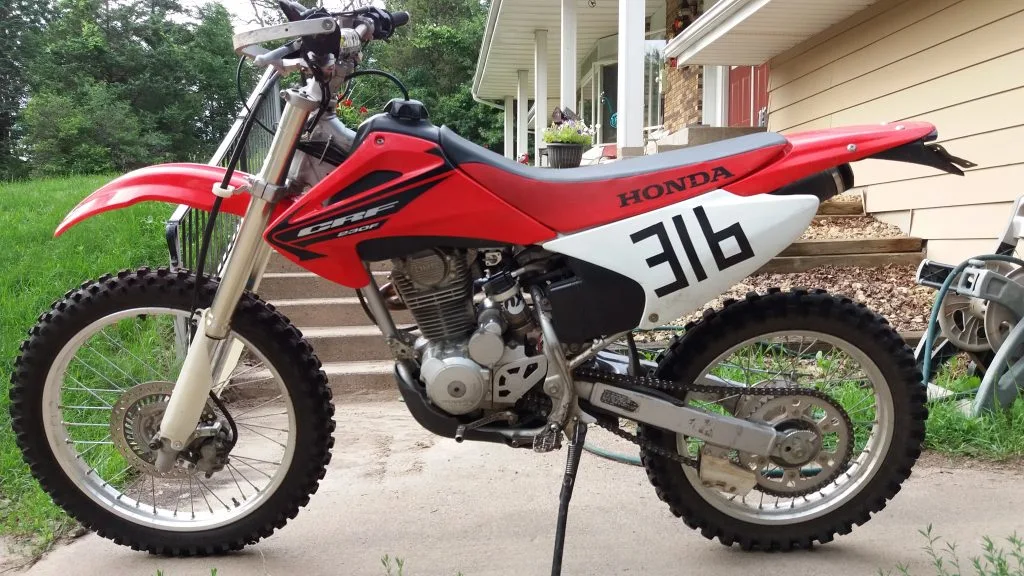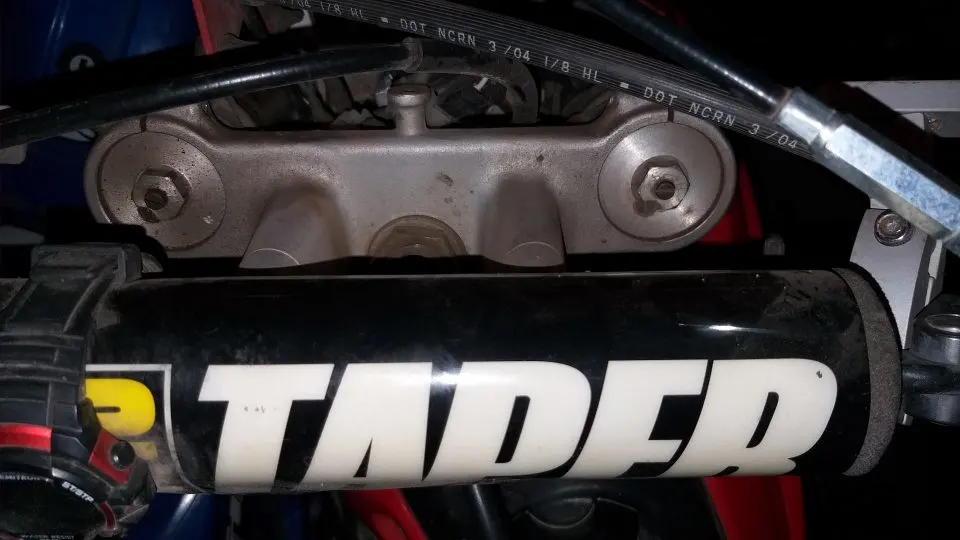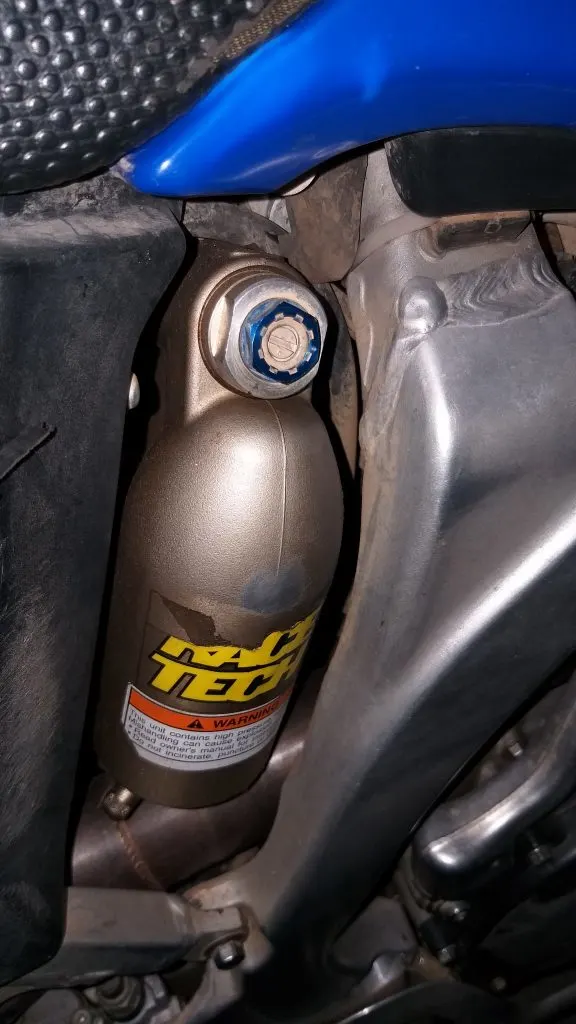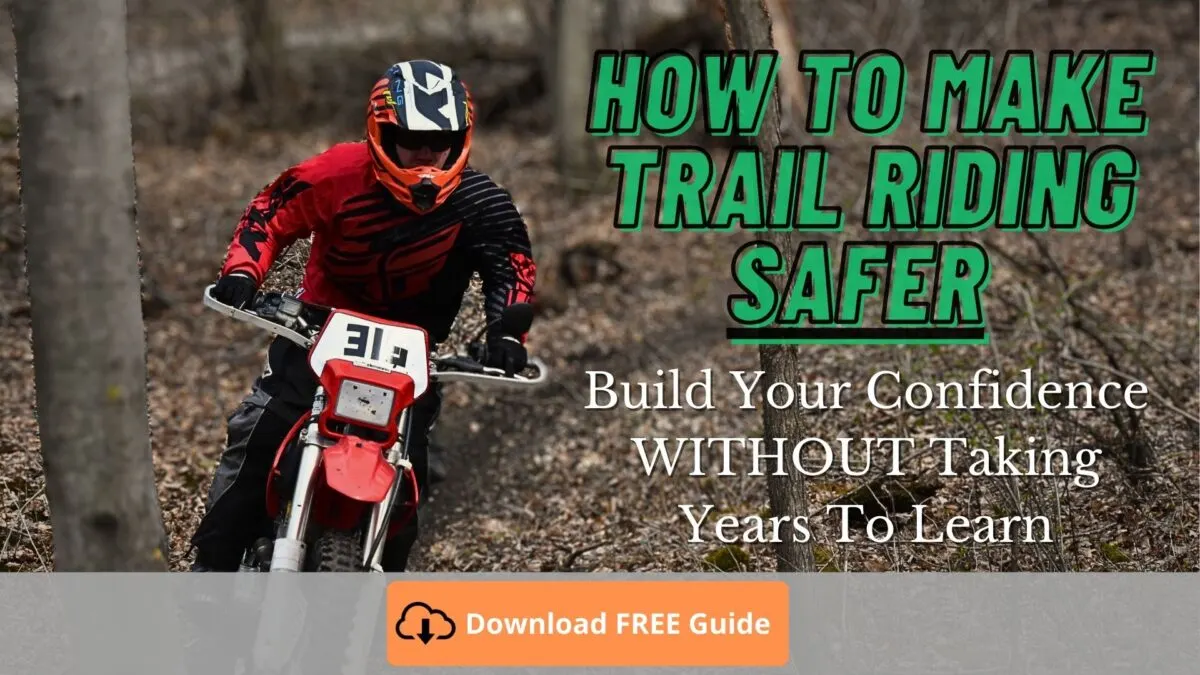The suspension on your dirt bike is one of the most important parts. It can be the difference between a comfortable ride and a dangerous ride.
If you’re new to dirt bike riding or simply want to understand how the suspension works on your dirt bike, this is the definitive guide for beginners. You’ll learn the basics of how the forks and shock work, as well as how to do basic adjustments and tuning to get a better-performing and more comfortable dirt bike.
How Does Dirt Bike Suspension Work?
Dirt bike suspension uses springs or air and internal oil damping to control the bike by absorbing bumps and obstacles on various off-road terrain.
The stiffer the suspension, the heavier a rider and harder the impact it can handle without feeling too harsh or bottoming out, as a general rule.

What Should I Do First To My Suspension?
To get things started, you need to set the sag or ride ride height of your dirt bike’s suspension.
Why is setting the sag important? Because the sag changes the balance of your bike. Properly balanced suspension will give you the best handling bike.
For example, if you have too much shock sag, the rear end of the bike will ride too low compared to the front. This changes the geometry of your bike so that it’s harder to steer.
Setting the sag requires the correct fork and shock spring rates for your weight, and then pre-loading them for the proper ride height.
What Is The Correct Spring Rate For Me?
Using the right spring rate is critical to properly setting up your suspension. If the springs are too soft, the suspension will bottom out easily. Too stiff and you’ll have a harsh ride that handles poorly.
Most full-size dirt bikes for adults are set up for 150-180lb riders, to give you an idea.
What Is Suspension Pre-Load?
Once you know that the spring rates are correct for your bike and weight, it’s time to set the pre-load.
Pre-load on dirt bike suspension is the amount of tension on the shock or fork springs that can be adjusted to set the sag.
Static Sag vs Rider Sag
Sag is simply how much the suspension compresses under weight.
Static is how much the suspension compresses under the weight of the dirt bike itself.
Rider sag is how much the suspension compresses with you (the rider) on the bike with all of your riding gear on. This is to simulate actual riding conditions.
More pre-load decreases the amount of sag, thus increasing the ride height.
What Should My Sag Be Set At?
For most full size dirt bikes, the rear shock should have a rider sag of between 95-110mm.
100mm is a good starting point, but to get the best performance, you should test, adjust 5mm differences, and test again until you feel the most comfortable riding the trail or terrain you normally ride.
You will want a little more sag for enduro or trail riding compared to motocross type riding.
More sag means it takes less of a load to compress the suspension, which is what you want for trail riding to give you more bump compliance for comfort.
Fork Sag Too?
The fork sag will be slightly less than the shock sag because more weight is on the rear shock when checking it.
A good starting point for rider fork sag (with you sitting on the bike) is 75mm. This would be about 25% of the total suspension travel for a full size dirt bike with 12 inches (305mm) of travel.
How To Adjust Shock Preload (Sag)
To adjust the sag on the shock, you need to break loose the top ring or locking ring and back it off at least one turn.
This can be done with a shock spanner wrench or a screwdriver and hammer. Be careful not to damage the tabs on the ring.
Once it’s loose, turn the lower ring/collar to adjust the preload. Turning it in (clockwise) increases the preload, which gives you less rider sag. Turning it up (counterclockwise) decreases the preload, which gives you more rider sag.
Pro tip: you can sometimes turn the shock spring with your hands to rotate the preload ring.
How To Adjust Fork Preload (Sag)
To add more preload (decrease rider sag), you can add a spacer on top of the fork springs. This can be plastic or metal as long as it is the same size as the spring so it doesn’t fall down.
To reduce the preload (increase rider sag)
How To Adjust Suspension Clickers
After you get your ride height adjusted and dialed in, it’s time to start playing with the clickers on your forks and shock.

Disclaimer: basic trail bikes or older dirt bikes may not have any adjustable clickers or components on the suspension.
The clickers on dirt bike suspension look like small screws that usually require a flat blade screwdriver to adjust them. Some dirt bikes have knobs that can be turned by your fingers.
The “clickers” will be directly on the top and bottom of each fork leg, and facing outward on the top and bottom of the shock body and/or shock reservoir.
What Do The Clickers Actually Do?
Great question! Turning the clickers on dirt bike suspension in or out will adjust the amount of compression or rebound damping.
What Is Suspension Damping?
Suspension damping controls the rate at which the forks or shock is compressed and rebounding. Oil is forced through shims, holes, valves, and various passages that are tuned for a specific type of riding, as well as rider weight and skill level.
Internally changing the damping of the suspension is often referred to as “Getting a suspension re-valve”. There are endless possibilities when it comes to fork and shock valving, and that is why technology is always changing and getting better as the years go on. New ideas are tested, refined, and then put into practice.
Suspension tuning really is an art, and that is why any major suspension valving change should be done by someone that knows what they are doing and why.
If you want to learn more about the why and how of suspension, order your copy of Race Tech’s Suspension Bible from Amazon Here. I read through it more than once and learned so much more about how each part of the forks and shock work.
Adjusting Compression and Rebound Damping
Getting back to the clickers, most motocross and enduro bikes have quite a bit of external damping adjustment.
Standard setting is in the middle. Most forks or shocks will have about 15-25 “clicks”.
Each click can be heard and felt, but it’s a very soft click, so pay careful attention when turning the clicker screw. Each click is about ¼-½ revolution of the screw.
Finding The Standard Setting
So, to find the standard setting, turn the damping screw all the way in (do this on all of the compression and damping screws, but one at a time). Now, back it out until it stops “clicking”.
Count how many clicks it takes, and then turn it back in to the halfway point. So if there’s 20 clicks, turn it so it’s 10 clicks out.
Making A Change
Now that everything is in the middle, go and ride your normal trail loop or lap around your track. Notice how everything feels, and then come back and make one change.
Try going 5 clicks in on just the compression of the forks. Going in will slow the damping down, which will make it feel stiffer.
Now go out and do the same loop or ride and pay attention to any differences.
Don’t feel anything? Stop and go another 5 clicks in.
Or is it worse? Turn it back out to the middle and then go 5 clicks out.
Opening the compression needle (clicker) up will speed up the compression of the forks and make it feel softer or more plush.
Finding Your Best Setting
Do this until you get the most comfortable setting on the compression of your forks.
Once you find the best setting, then move on to the rebound damping of the forks.
After you get the forks all dialed in, then start the process over again with the rear shock.
What Is High Speed Compression Damping?
High speed compression damping is an adjustment made to tune the damping for high speed suspension movements.
What this doesn’t mean: tuning your suspension for when you ride your dirt bike at high speeds.
What this really means: Any time you hit a sharp bump or rock that quickly compresses the suspension. That is the type of damping that the high speed circuit is tuning for.
I have found adjusting the high speed compression on my rear shock to be super helpful for trail riding. Tuning the high speed damping can really make a difference on how plush of a ride you have and feel.
How To Adjust High Speed Compression
It’s basically the same as the standard compression, just a different knob.
On the rear shock, it’s generally the outer hex knob on the reservoir. It’s the same location as the click, so look at the outer hex/but. It’s sometimes colored red or blue.

What Is Air Gap/Fork Oil Level?
Fork oil level or height, also known as air gap, is the distance from the top of the oil in the fork tube to the top of the fork leg when the fork is fully compressed. When you add more oil (decrease the air gap) the fork is harder to compress, making the suspension stiffer.
This measurement must be done with the spring removed, and it’s easiest when the fork is off the bike by itself.
What Is “Bottoming Out The Suspension”?
Bottoming out the suspension is when the suspension is fully compressed and cannot absorb any more force. Some shocks have a “bottom out” rubber stopper to help prevent any damage.
There is usually a “metal clunk” sound when the suspension is bottomed out because the metal suspension parts, such as the fork tubes have reached their travel limit and collided.
Bottoming out usually happens because of an unusually hard impact
How To Prevent Bottoming
There’s a number of ways to try and prevent suspension bottoming from happening. You can:
- Increase the spring rate
- Slow down the compression damping
- Increase the oil level/reduce air gap (forks only)
- Change to a heavier weight fork oil (Amazon)
All of these can help reduce the chance of bottoming from happening, but they all will affect other characteristics of how the suspension works. For example, increasing spring rate is the most effective way to prevent bottoming, but it will also result in a stiffer riding dirt bike.
A spring rate may need to be changed if bottoming is a common occurrence. If it is only an occasional problem, then trying one small thing at a time is most efficient.
Trial and error is the best way to learn how things work on your dirt bike. Plus, once you figure out a setting that you like, you will have a great sense of accomplishing something that makes you more comfortable as well as faster on the bike, and you did it all by yourself!
How To Make Dirt Bike Suspension Stiffer
There’s a number of ways to make the forks and shock stiffer. The question is, where do you want it stiffer?
You can make your suspension stiffer by:
- Increasing spring rate: stiffer springs
- Slowing down the compression or rebound damping: turning the clickers in
- Using heavier weight fork/shock oil
- Add more fork oil (see caution below)
- Changing internal valving
- Increasing tire pressure (Yes, I’m serious; it will at least feel stiffer)
How To Make Dirt Bike Suspension Softer
And vice-versa, you can also make your suspension softer by:
- Decreasing spring rate: softer springs
- Speeding up the compression or rebound damping: turning clickers out
- Using lighter weight fork/shock oil
- Removing fork oil: increasing air gap
- Change internal valving
- Decreasing tire pressure
Tips and Caution For Tuning
Obviously, you can do some major harm if you start changing things on your suspension if you aren’t careful or know what you’re doing.
With that said, it’s really not that hard to make basic changes that really make a difference if you just follow this guide.
Things to remember:
- Record your original settings before making any changes
- Set your sag first to balance your dirt bike’s suspension
- Always make one change at a time
- Don’t be afraid to make quick changes
- If you get lost, go back to the original settings
- If you’re still unsure about a certain change, ask an expert for help
Maximum Fork Oil Level
Raising or lowering the fork oil level (air gap) can make a big impact on how the suspension feels. Just be careful not to add too much fork oil if you’re raising the level (decreasing the air gap). Refer to your owner’s manual for maximum oil level specs. Every dirt bike fork has different specifications.
The best mod for your money
Suspension is just one of the key factors you need to ride with skill and speed without crashing. The best mod you can do is upgrade the rider.
Yes, you could stick Graham Jarvis, Cody Webb, or Eli Tomac on your dirt bike, but I’m talking about YOU personally. Have you ever gotten proper training? It makes a world of difference when you have the confidence to keep your bike in control.
Want to get started riding safer by building your confidence? Click or tap here to learn proper off-road riding technique.


